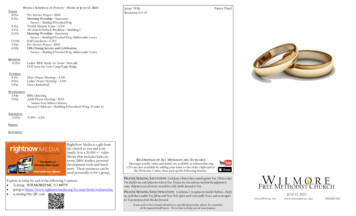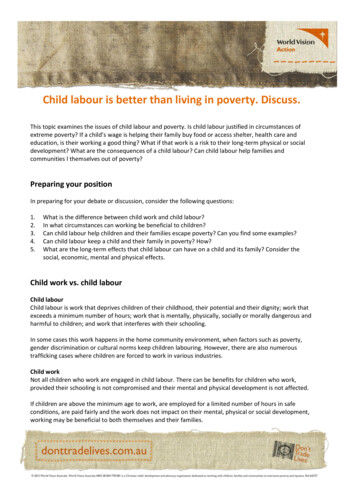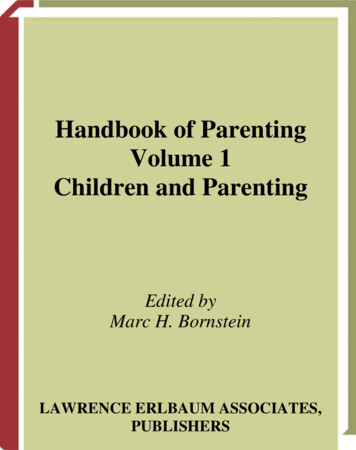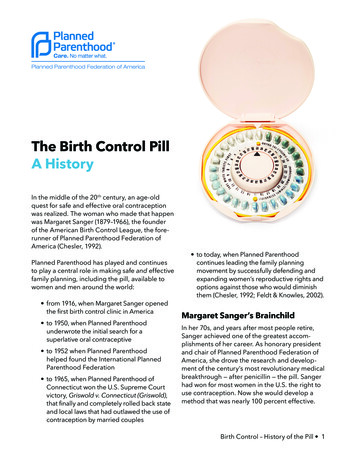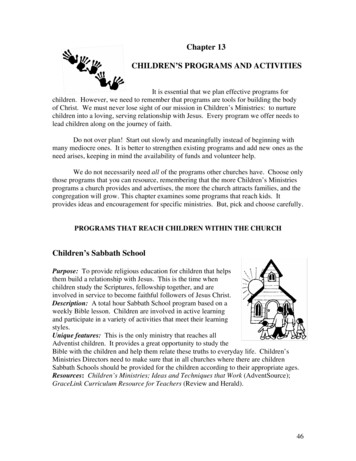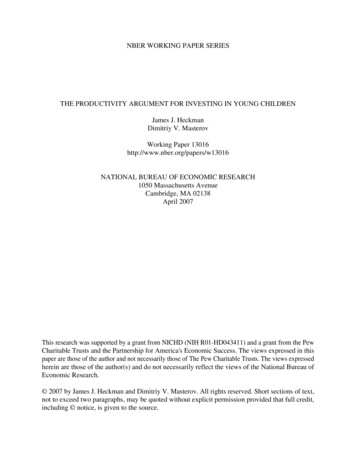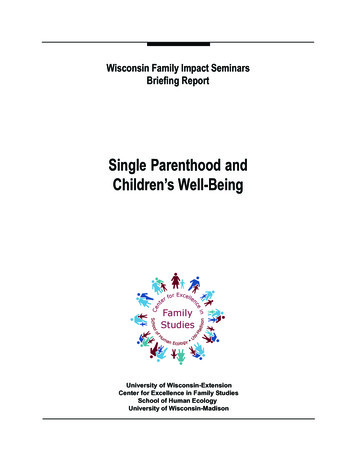
Transcription
Wisconsin Family Impact SeminarsBriefing Reportfor ntSingle Parenthood andChildren’s Well-BeingUn Ecology University of Wisconsin-ExtensionCenter for Excellence in Family StudiesSchool of Human EcologyUniversity of Wisconsin-Madison
Single Parenthood andChildren’s Well-BeingSecond EditionWisconsin Family Impact SeminarsBriefing ReportBy:Karen BogenschneiderAsst. Professor, Child & Family Studies, UW-MadisonFamily Policy Specialist, Cooperative ExtensionDirector, Wisconsin Family Impact Seminars&Tom KaplanInstitute for Research on Poverty&Kari MorganResearch AssistantWisconsin Family Impact SeminarsDesign by:Bonnie RiederOctober 1993University of Wisconsin-ExtensionCenter for Excellence in Family StudiesSchool of Human EcologyUniversity of Wisconsin-MadisoWe gratefully acknowledge the financial support of the:Helen Bader Foundation, Inc.The Lynde and Harry Bradley Foundation
Table of ContentsWisconsin Family Impact Seminars . 1Executive Summary: Single Parenthood and Children’s Well-Being . 3Introduction . 5Single Parent Households in Wisconsin . 6What Are the Effects for Children? . 18Why Single Parenthood Affects Children . 23Policy Implications . 27Promoting Strong Stable Two-Parent Families . 27Improving the Quality of Marriage . 28Providing Education for Parents . 30Putting Children First When Parents Divorce . 31Increasing the Economic Security of Children . 32Building Community Resources for Children . 35Wisconsin Resources on Single Parent Families . 37Data on Family Structure . 37Marriage and Family Counseling . 38Church/Synagogue-Based Premarital Counselingand Marital Enrichment . 39Conclusion . 40References . 41Appendix A . 46The Seven Policy Proposals Cited in This ReportWisconsin Family Impact Seminarsiii
Wisconsin Family Impact Seminars“Single Parenthood and Children’s Well-Being” is the 2nd seminar in a series designed tobring a family focus to policymaking. This seminar featured the following speakers:Tom KaplanSenior Scientist, Institute for Research on PovertyRoom 6402 Social Science Building1180 Observatory DriveMadison, WI 53706(608) 262-0345Email: kaplan@ssc.wisc.eduDean Hamilton McCubbinSchool of Human Ecology141 Human Ecology Building1300 Linden DriveMadison, WI 53706(608) 262-4847Email: mccubbin@macc.wisc.eduDaniel MeyerAsst. Professor, School of Social WorkAffiliate, Institute for Research on PovertyRoom 3434 Social Science Building1180 Observatory DriveMadison, WI 53706(608) 262-7336Email: meyer@ssc.wisc.eduGary SandefurProfessor of SociologyAffiliate, Center for Demography and Ecology,and Institute for Research on PovertyRoom 3450 Social Science Building1180 Observatory DriveUniversity of Wisconsin-MadisonMadison, WI 53706(608) 262-0037Email: sandefur@ssc.wisc.eduFor further information on the seminar series, contact director, Karen Bogenschneider, Associate Professor, UW-Madison/Extension, 120 Human Ecology,1300 Linden Drive, Madison, WI 53706; telephone: (608) 262-4070 or262-8121; email: kpbogens@facstaff.wisc.edu.Wisconsin Family Impact Seminars1
Family Impact Seminars have been well-received in Washington, D.C., by federal policymakers, and Wisconsin is one of the first states to sponsor the seminars for state policymakers. Family Impact Seminars provide state-of-the-art research on current family issues for state legislators and their aides, Governor’sOffice staff, state agency representatives, educators, and service providers. Basedon a growing realization that one of the best ways to help individuals is bystrengthening their families, Family Impact Seminars analyze the consequencesan issue, policy, or program may have for families.Each seminar is accompanied by an in-depth briefing report that summarizes thelatest research on a topic and identifies policy options from across the politicalspectrum. Copies are available at Extension Publications, 630 West MifflinStreet, Room 170, Madison, WI 53703, (608) 262-3346 (voice and TDD); (608)265-8052 (fax).“Building Policies That Put Families First:A Wisconsin Perspective”“Single Parenthood and Children’s Well-Being”2March 1993October 1993Wisconsin Family Impact Seminars
Executive SummarySingle Parenthood and Children’s Well-BeingAbout half of all children born today are expected to spend some time in asingle parent family before reaching age 18. Recent evidence suggeststhat children from single parent families do less well, on average, thanchildren who live with both of their parents. These findings do not mean that every child growing up in a single parent family will do worse than a similarlysituated child in a two-parent family. What these findings do mean is that singleparenthood increases the odds or the risk that children’s well-being will suffer.Children growing up in a single parent household is a more common occurrencein Wisconsin today than thirty years ago. Of all family households with children, the percentage headed by a married couple declined from 94 percent to 78percent between 1960 and 1990, while the percentage headed by a single womanrose from 5 percent to 18 percent; during the same time period, the percentageheaded by a single man rose from 1 to 4 percent. Thus, the number of marriedcouple families with children in Wisconsin declined by 4 percent from 1960 to1990, while the number of female-headed families rose by 298 percent in thatsame period. Since these statistics represent only one point in time, they tend tounderrepresent the kaleidoscope of family forms that many children experiencesingle parenthood, cohabitation, marriage, divorce, remarriage, and a subsequentdivorce.Over the 1980s, an increasing percentage of Wisconsin single parents were nevermarried, whereas the proportion of single parents who were separated, divorced,or widowed has declined. Since 1970, the percentage of births to unmarriedmothers has grown substantially in Wisconsin, representing 25 percent of the livebirths in the state in 1991, compared with a national rate of 28 percent. Of the12 Wisconsin counties that exceeded the statewide average of births to singlemothers, almost all were in southeastern or northern Wisconsin. The likelihoodthat a birth to a teenager will be a nonmarital birth has increased almost continuously since 1960.Children who live with only one of their parents do less well in school, obtainfewer years of education, and have trouble keeping a steady job as young adults.Children from single parent families are six times more likely to be poor.Daughters of single parents are more likely to bear a child out-of-wedlock, divorce, and receive welfare benefits as young adults. Psychological problems andbehavior problems are more likely in offspring from single parent or remarriedfamilies. In the majority of families, single parenthood seriously disrupts the relationship between children and the noncustodial parent, usually the father.With few exceptions, single parenthood appears to disadvantage children regardless of race, ethnicity, social class, or sex. Neither the age of the child nor thetype of marital disruption appears to make a difference. While single parenthoodWisconsin Family Impact Seminars3
doubles or more than doubles the risk that children’s well-being will suffer, it isnot the major or the only cause of the problems facing children. Even though therates of serious problems are more than two to three times greater for children indivorced or remarried homes compared to nondivorced homes, the majority ofyoung people from disrupted families finish high school, do not display high levels of problem behaviors, and enjoy reasonable relationships with their mothers.Understanding why family instability places some children at greater risk is essential in planning programs and policies to promote healthy children and families. As the growing body of research evidence indicates, there is no single causefor the declining well-being of children in single parent families, but rathermany. When greater risks are found, the differences appear to result from economic hardship, loss of parental support and supervision, lack of community resources, parental conflict, and life stress and instability. No single explanationaccounts for the differences, and some scientific support exists for each of theseperspectives. Thus, programs and policies are most apt to be effective if they arecomprehensive and multi-faceted, addressing multiple risk factors.In the spirit of encouraging debate about the potential consequences of a range ofpolicy strategies, the paper briefly summarizes policy proposals from seven different, sometimes contradictory, sources spanning the political spectrum:Furstenberg and Cherlin (1991); Garfinkel and McLanahan (1986); McLanahanand Sandefur (in press); the National Commission on America’s Urban Families(1993); the National Commission on Children (1993a, 1993b); Whitehead(1993); and Zill (1983).The policy options recommended by these authoritative sources are summarizedin six categories: promoting strong stable two-parent families, improving thequality of marriage, providing education for parents, putting children first whenparents divorce, increasing the economic security of children, and building community resources for children.The paper concludes by identifying resources in Wisconsin for locating information on family structure; marriage and family counseling; and church/synagoguebased premarital counseling and marital enrichment programs.4Executive Summary
IntroductionAbout half of all children born today are expected to spend some time in asingle parent family before reaching age 18. For the first time in history,children are more apt to live in a single parent family for reasons otherthan the death of a spouse. About one-fourth of all children are born to an unmarried mother; half of the children born to teenagers are born outside of marriage(Cherlin, 1992), although some of these do marry later. Furthermore, it is estimated that about 40 percent of all children under 18 will experience the break-upof their parents’ marriage, and 15 percent will witness divorce twice. Increasingly, children experience a kaleidoscope of family forms single parenthood, cohabitation, marriage, divorce, remarriage, and a subsequent divorce (Cherlin,1992).Today’s children have been caught up in “a tidal wave of family change”(Cherlin, 1992). The main questions this paper will address are what consequences these changes have for children’s well-being, and what are the policyimplications. About a decade ago, the conventional wisdom was that single parenthood had no long-lasting disadvantages for children. The consequences of divorce, in particular, could be compared to that of a common cold an initial periodof acute discomfort followed by a rapid recovery (Whitehead, 1993). In the yearfollowing divorce, preschoolers exhibited emotional distress, behavioral problems, and disrupted peer relations; two years after the divorce, however, boyshad improved dramatically and girls were showing no more problems than girlsin non-divorced families (Hetherington, 1989, 1991; Zill, 1983).Recent evidence suggests, however, that children from single parent families doless well, on average, than children who grow up with both of their parents. Children who grow up with only one parent are more likely to drop out of school,bear a child out-of-wedlock, and have trouble keeping a steady job as youngadults.Findings such as these are often misinterpreted to mean that two parents are always good for children and that every child growing up with a single parent willbe less successful. Statistically, significant findings do not mean that every childgrowing up in a single parent family will do worse than a similarly-situated childin a two-parent family. Quite to the contrary, some children who grow up insingle parent families do better than children who grow up in two-parent families. What these findings do mean is that single parenthood increases the odds orthe risk that children’s well-being will suffer.Wisconsin Family Impact Seminars5
Single Parenthood Households in WisconsinSummary Statements As in the nation generally, Wisconsin households are less likely to containchildren now than was the case thirty years ago. Among Wisconsin households that do contain children, proportionatelymore are headed by single parents today than thirty years ago. Judging in part from national data, it is likely that, over the 1980s, an increasing percentage of Wisconsin single parents were never married,whereas the proportion of single parents who were separated, divorced,or widowed declined. Since 1970, the percentage of births that are to unmarried mothers hasgrown substantially in Wisconsin and the nation, although the Wisconsinpercentages remain somewhat under the national percentages. After a period (1960-1988) of decline in the birthrate among teenagers,the rate has recently started to climb in both Wisconsin and the nation.The likelihood that a birth to a teenager will be a nonmarital birth has increased almost continuously since 1960.The Percentage of Households Containing ChildrenAs Table 1 indicates, the percentage of households in Wisconsin containing children declined from 49% in 1960 to 36% in 1990. The Table also indicates thatthe percentage of all Wisconsin households containing a married couple with children has declined faster (from 46% in 1960 to 28% in 1990) than has the overallpercentage of households with children.The Increasing Frequency of Single-Parent HouseholdsTable 2 suggests why the drop in married-couple families with children has exceeded the decline in all households with children: single-parent households havebecome more common. Of all family households with children, the percentageheaded by a married couple declined from 94% to 78% between 1960 and 1990,the percentage headed by a single woman rose from 5% to 18%, and the percentage headed by a single man rose from 1% in 1960 to 4% in 1990.6Single Parent Households in Wisconsin
Table 1Households with Children Compared to All Households in Wisconsin1960-1990All 18550,856506,01841.233.327.8Family Households with ChildrenNumber562,645Percentage of AllHouseholds49.1Married-Couple Family Households with ChildrenNumber527,377Percentage of AllHouseholds46.0Source: U.S. Census data, 1960-1990, reported in Wisconsin Family Impact Seminars, BriefingReport #1 (Madison: University of Wisconsin Center for Family Studies, March 1993).Table 2Types of Family Households with Children in 42713.0118,00418.110,1501.713,0612.026,6064.1All Family Households with ChildrenNumber562,645Married Couple with ChildrenNumberPercentage527,37793.7Female Headed with ChildrenNumberPercentage29,6815.3Male Headed with ChildrenNumberPercentage5,5871.0Source: U.S. Census data, 1960-1990, reported in Wisconsin Family Impact Seminars, BriefingReport #1.Wisconsin Family Impact Seminars7
Table 3 summarizes this information in a different way, showing the percentagechange in various household types between 1960 and 1990. The number of married-couple families with children in Wisconsin declined by 4% from 1960 through1990. The number of female-headed families rose by 298% in that period, andthe number of male-headed families rose by 376%.Numbers of Children in Single-Parent HouseholdsThe 1990 Census indicated that 18.1% of all Wisconsin children resided in households headed by single parents, compared to the 1980 level of 13.5% of children.As Table 4 indicates, the range by county of children in single-parent householdsextended in 1990 from a low of 9.6% in Taylor County to highs of 57.1% inMenominee County and 38.2% in Milwaukee County. The 1990 rates in thirteenWisconsin counties exceeded the statewide rate. As Map 1 indicates, the thirteen were generally in northern or southeastern Wisconsin.Table 3Percentage Change among Family Household Types in l Families with Children 7.9 6.8 0.4 15.6Married Couple 4.3 0.2-8.1-4.1Female Head 58.8 79.2 39.8 297.6Male Head 81.7 28.7 103.7 376.2Source: U.S. Census data, 1960-1990, reported in Wisconsin Family Impact Seminars, BriefingReport #1.8Single Parent Households in Wisconsin
Table 4Percentage of Children in Single-Parent Families in Wisconsin Counties,1980-1990County19801990Percentage glasDunnEau ClaireFlorenceFond du LacForestGrantGreenGreen .910.9JeffersonJuneauKenoshaKewauneeLa .14.88.23.57.5Wisconsin Family Impact Seminars9
County19801990Percentage 52.33.4PortagePriceRacineRichlandRockRuskSt. .04.13.43.4Source: U.S. Census, 1980 and 199010Single Parent Households in Wisconsin
Wisconsin has a lower percentage of children in single-parent households thandoes the nation as a whole, as shown in Table 5.Table 5Percentages of U.S. and Wisconsin Children in Single-Parent Households1980 and 199019801990Wisconsin13.5%18.1%United States17.0%20.2%Source: U.S. Census, 1980 and 1990.Note: These percentages compare children (persons under age 18) in single-parent households toall children, including children residing with parents or relatives, children in institutions, childrenwho are married themselves, and other children not living in a household headed by a parent.Complexities in the Measurement of Single-Parent HouseholdsFigures from the decennial census on the number of children in single-parentfamilies are point-in-time counts taken in April of each decennial census year.The figures are sometimes thought to misrepresent the prevalence of the singleparenthood experience. At least two forms of undercounting are said to exist.First, many more children experience life in a single-parent family at some pointbefore their 18th birthday than are captured in one point-in-time count. Second,some children counted in the decennial census as living in a married-couplehousehold are not living with both biological parents, but rather with one biologicalparent and a stepparent.Of all U.S. children living in married-couple families in 1990, about 16% (asTable 6 indicates) lived in a household with a stepparent.Table 6Types of Married-Couple Households with Children, United States1980-1990198019851990Biological Mother and Father83.7%82.1%81.5%Biological Parent and Stepparent12.8%14.9%15.9%Adoptive Mother and Father2.9%1.9%2.1%Unknown Mother or Father0.6%1.1%0.4%Source: U.S House of Representatives, Committee on Ways and Means, 1993 Green Book(Washington, D.C.: GPO, 1993), p. 1125; based on data in U.S. Bureau of the Census, CurrentPopulation Reports, P 23, no. 180, “Marriage, Divorce, and Remarriage in the 1990s,” 1992.Wisconsin Family Impact Seminars11
In another way, however, the decennial census may overstate the prevalence ofsingle parenthood, because a child residing with two cohabiting but unmarriedbirth parents will be reported as living in a single-parent household. Data fromtwo national surveys (the 1987 Current Population Survey and the National Survey of Families and Households), both of which characterize the United States asa whole but not any individual state, show that over 40% of households with unrelated, opposite-sex adults contained children. In an unknown number of thesecases, the two adults would both be biological parents of the resident children.The Marital Status of Single ParentsThe Current Population Survey (CPS), a nationally representative survey conducted annually by the Census Bureau, also reports on the marital status (divorced, separated, widowed, or never married) of single parents. BecauseWisconsin’s overall rate of single parenthood is close enough to the national rate,CPS statistics may be used to provide a rough description of the Wisconsin situation. In the United States in 1990, as Table 7 indicates, about 39% of children living in a single-parent household resided with a divorced parent, compared to 42%in 1980. The percentage of children in single-parent households living with widowed and separated parents also declined during the 1980s. In contrast, the percentage of children in single-parent households who resided with a never-marriedparent rose from 15% in 1980 to 31% in 1990. Most of that increase occurred inthe first half of the decade.Table 7U.S. Children Living with One Parent, by Marital Status of Parent1980-1990198019851990Never Married14.6%25.7%30.6%Married, Spouse 2.4%41.2%38.6%Source: U.S House of Representatives, Committee on Ways and Means, 1993 Green Book(Washington, D.C.: GPO, 1993), p. 1120; based on data in U.S. Bureau of the Census, CurrentPopulation Reports, Series P-20.12Single Parent Households in Wisconsin
Births to Single MothersOne relevant figure available annually from state vital records agencies is thepercentage of births to single mothers. In interpreting this data, it may be worthremembering that, in the United States as a whole, according to the CPS, 29% ofbirths to unmarried white women and 18% of births to unmarried black womenwere to cohabiting women in the period from 1970 to 1984 (Source: U.S. Houseof Representatives, Committee on Ways and Means, 1993 Green Book, p. 1128).Over the last three years for which published records are available in Wisconsin,births to single parents have represented 23-25% of all live births in the state(23% in 1989, 24% in 1990, and 25% in 1991). This is slightly below the nationalrate of 28%. Table 8 summarizes recent state and national rates.Table 8Births to Unmarried Mothers as a Percentage of All Births1970WisconsinUnited : Wisconsin Department of Health and Social Services, Center for Health Statistics, VitalStatistics 1988, p. 27; Wisconsin Department of Health and Social Services, Center for HealthStatistics, Maternal and Child Health Statistics, Wisconsin 1990, Table 2.7.2; U.S. House of Representatives, Committee on Ways and Means 1993 Green Book, p. 1113.Wisconsin Family Impact Seminars13
Table 9 shows the percentage of births to single mothers by Wisconsin county in1991.Table 9Percentages of Live Births to Single Mothers in Wisconsin Counties, uglasDunnEau ClaireFlorenceFond du LacForestGrantGreenGreen 18IowaIronJacksonJeffersonJuneauKenoshaKewauneeLa hlandRockRuskSt. 211516171332192112102318181825Source: Wisconsin Department of Health and Social Services, Center for Health Statistics, Maternal and Child Health Statistics, Wisconsin 1991, Table 2.7.2.As is true with census statistics on children in single-parent families, Menomineeand Milwaukee Counties show the highest rates of births to single parents. Map2 indicates that, of the 12 Wisconsin counties that exceeded the statewide average of 25% of births to single mothers, almost all were in southeastern or northern Wisconsin. Many were the same counties that exceeded the statewide average in single-parent households.14Single Parent Households in Wisconsin
Births to Teenage MothersNot all births to teenage mothers in Wisconsin are nonmarital births, but the likelihood that a birth to a Wisconsin teen will be nonmarital has increased significantly over the last thirty years, as Table 10 indicates.During most of this thirty-year period, the teen birthrate (that is, the number ofbirths per thousand teenage females) was declining, even as increasing percentages of those births were to single mothers. In the mid-1980s, however, in bothWisconsin and the nation as a whole, the long-term decline in the rate of births toteens ended. Over the last few years the rate has begun to rise, as Table 11 indicates.Table 10Nonmarital Births to Teenagers as a Percentage of All Birthsto Teenagers in Wisconsin196019701980199015-17-Year-Old Mothers18%53%71%90%18-19-Year-Old Mothers7%26%41%76%Source: Wisconsin Department of Health and Social Services, Center for Health Statistics,Health Data Review, Vol. 7, No. 5 (May 1993), p. 4.Table 11Teen Birthrates for Selected Years1960-19911960 1970 1980 1985 1986 1987 1988 1989 1990 ited 1582808078808489--18-19-Year-OldsWisconsinUnited StatesSource: Wisconsin Department of Health and Social Services, Center for Health Statistics,Health Data Review, Vol. 7, No. 5 (May 1993), p.2.Note: Birthrates are calculated as the number of live births per thousand females in the age category. A dash indicates that the data are not available.Wisconsin Family Impact Seminars15
Map 1Counties Exceeding the Statewide Percentageof Children in Single-Parent hippewaDunnEau uSaukIowaColumbiaDaneGrantLaFayetteGreenKewauBrown neeManitoWinne- tteLincolnTaylorSt. CroixFlorenceOneidaSheboyganFond duLacDodgeWashingtonJeffer- Wauson keshaRockOzaukeeMilwaukeeWal- RacineworthKenoshaSource: U.S. Census.Note: The lined counties exceeded the statewide average of 18.1%. See also the note to Table 5.16Single Parent Households in Wisconsin
Map 2Counties Exceeding the Statewide Average ofBirths to RuskBarronLincolnTaylorSt. CroixFlorenceOneidaPriceLangladeChippewaDunnEau ge ManitoWinne- Calu- w o cbago m e tWausharaMarquetteGreenLakeColumbiaSheboyganFond duLacDodgeWashingtonJeffer- Wauson keshaDaneGrantLaFayette GreenKewauBrown neeRockOzaukeeMilwaukeeWal- RacineworthKenoshaSource: Wisconsin Department of Health and Social Services, Center for Health Statistics, Material and Child Health Statistics 1991, Table 2.7.2.Note: The lined counties exceeded the statewide average of 24%.Wisconsin Family Impact Seminars17
What Are the Effects for Children?Adecade ago, the prevailing view was that single parenthood had no longterm effects on children; even though earlier studies suggested negativeeffects, many were based on small clinical samples and few consideredthe influence of social class. Even though some studies continue to show no effects, recent evidence from more representative samples suggests children wholive with only one parent do less well than children who live with both parentson several measures of child well-being (Amato & Keith, 1991; Furstenberg,Brooks-Gunn, & Chase-Lansdale, 1989; Hetherington, 1993; McLanahan &Booth, 1989; McLanahan & Sandefur, in press; Zill, Morrison, & Coiro, 1993).Similarly, a recent review of 92 studies of divorce involving 13,00
single parenthood, cohabitation, marriage, divorce, remarriage, and a subsequent divorce. Over the 1980s, an increasing percentage of Wisconsin single parents were never married, whereas the proportion of single parents who were separated, divorced, or widowed has declined. Since 1970, the percentage of births to unmarried
